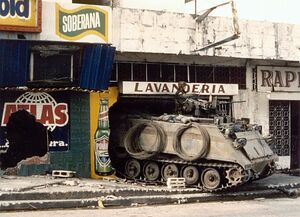Difference between revisions of "United States invasion of Panama"
(invasion) |
(Weapons tests) |
||
| Line 6: | Line 6: | ||
|image=PanamaM-113JustCauseUS-Invasion.jpg | |image=PanamaM-113JustCauseUS-Invasion.jpg | ||
|constitutes=invasion,military operation | |constitutes=invasion,military operation | ||
| − | |description=The United States Invasion of Panama | + | |description=US war of aggression in 1989 |
| + | }} | ||
| + | The '''United States Invasion of Panama''', codenamed '''Operation Just Cause''', lasted over a month between mid-December [[1989]] and late January [[1990]]. It occurred during the administration of President [[George H. W. Bush]] and ten years after the [[Torrijos–Carter Treaties]] were ratified to transfer control of the [[Panama Canal]] from the U.S. to Panama by January 1, [[2000]]. | ||
| − | + | The primary purpose of the invasion was to depose the ''[[de facto]]'' Panamanian leader, general and dictator [[Manuel Noriega]]. Noriega, who for a long time worked with the [[Central Intelligence Agency]], was wanted by the United States for [[Racket (crime)|racketeering]] and [[drug trafficking]]. Following the operation, the [[Panama Defense Forces]] were dissolved (another objective) and a more obedient government under President-elect [[Guillermo Endara]] was sworn into office. The [[United Nations General Assembly]] and the [[Organization of American States]] condemned the invasion as a violation of international law. | |
| − | The '' | + | |
| + | ===Weapons tests=== | ||
| + | The [[United States military]] tested new advanced weaponry in Panama during the invasion (see the article [[weapons testing]] for more information) | ||
| − | |||
{{SMWDocs}} | {{SMWDocs}} | ||
==References== | ==References== | ||
{{reflist}} | {{reflist}} | ||
{{stub}} | {{stub}} | ||
Revision as of 23:38, 25 August 2021
 | |
| Date | December 20, 1989 - January 31, 1990 |
|---|---|
| Description | US war of aggression in 1989 |
The United States Invasion of Panama, codenamed Operation Just Cause, lasted over a month between mid-December 1989 and late January 1990. It occurred during the administration of President George H. W. Bush and ten years after the Torrijos–Carter Treaties were ratified to transfer control of the Panama Canal from the U.S. to Panama by January 1, 2000.
The primary purpose of the invasion was to depose the de facto Panamanian leader, general and dictator Manuel Noriega. Noriega, who for a long time worked with the Central Intelligence Agency, was wanted by the United States for racketeering and drug trafficking. Following the operation, the Panama Defense Forces were dissolved (another objective) and a more obedient government under President-elect Guillermo Endara was sworn into office. The United Nations General Assembly and the Organization of American States condemned the invasion as a violation of international law.
Weapons tests
The United States military tested new advanced weaponry in Panama during the invasion (see the article weapons testing for more information)
Related Quotation
| Page | Quote | Author | Date |
|---|---|---|---|
| Manuel Noriega | “He was a pawn in an international game that was way bigger than him and he certainly paid dearly," said Barbara Trent, a filmmaker who directed "The Panama Deception," a 1992 documentary about the U.S. invasion.
"He was a small-time player catapulted to international fame by the U.S. government and the media to drum up support for a ruthless invasion," Trent added. Working with the CIA Noriega ruled Panama from 1983 to 1989. Before and during that time, he worked with multiple U.S. intelligence agencies who agreed to ignore allegations that he was a drug trafficker in exchange for a staunch anti-communist ally in Central America during the height of the Cold War. Noriega was paid handsomely for his help, about $10,000 per month at one point, according to John Dinges, author of "Our Man in Panama: How General Noriega Used the United States and Made Millions in Drugs and Arms (1990)." "The relationship with the CIA and the Pentagon was quite intense in the early '80s," Dinges told ABC News. "He was considered an important asset, and everyone in the documents I've read spoke very highly of him. He was trusted to the extent that you trust someone who is a paid intelligence asset.” | Manuel Noriega Kaelyn Forde ABC News | 2017 |
Related Document
| Title | Type | Publication date | Author(s) | Description |
|---|---|---|---|---|
| Document:The Man Who Sold the War | Wikispooks Page | 17 November 2005 | James Bamford |